Playing cards in Wales - Welsh playing cards
Whereas the distinctiveness of Wales is an important resource contributing to the rich texture of variety which characterises the island of Britain, to date no Welsh playing cards cards have been found which were actually manufactured in Wales.

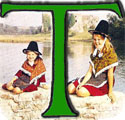 HERE doesn't appear to be a very prolific history of playing cards in Wales,
possibly on account of religious views and the fact that the Licensing Act made printing illegal outside London, Oxford and Cambridge until 1695.
Added to this was the difficulty of distribution to remote areas.
The following entry in 1463 PARLIAMENT ROLLS states:
In the third year of Edward IV a statute was issued prohibiting, as from the following Michaelmas day (Sept 29, 1464)
the importation into England and Wales of various “chaffares, wares, ou choses desoubs escriptes.”
These included fire-tongs, dripping pans, dice, tennis balls, pins, pattins, pack-needles, painted wares, daggers, woodknives,
bodkins, tailor's shears, razors and “Cardes a jouer.”
Playing cards may have been imported into Wales as early as the fifteenth century either directly through sea ports such as
Holyhead, Conwy or Cardiff, or else via England.
Listings in Port Books and customs duties paid may shed some light on official imports, but not the illegal ones.
In any case there is no evidence of a Welsh playing card tradition.
HERE doesn't appear to be a very prolific history of playing cards in Wales,
possibly on account of religious views and the fact that the Licensing Act made printing illegal outside London, Oxford and Cambridge until 1695.
Added to this was the difficulty of distribution to remote areas.
The following entry in 1463 PARLIAMENT ROLLS states:
In the third year of Edward IV a statute was issued prohibiting, as from the following Michaelmas day (Sept 29, 1464)
the importation into England and Wales of various “chaffares, wares, ou choses desoubs escriptes.”
These included fire-tongs, dripping pans, dice, tennis balls, pins, pattins, pack-needles, painted wares, daggers, woodknives,
bodkins, tailor's shears, razors and “Cardes a jouer.”
Playing cards may have been imported into Wales as early as the fifteenth century either directly through sea ports such as
Holyhead, Conwy or Cardiff, or else via England.
Listings in Port Books and customs duties paid may shed some light on official imports, but not the illegal ones.
In any case there is no evidence of a Welsh playing card tradition.

The first Welsh Bible was printed in 1588. Whilst a succession of master printers has left a legacy of well produced books and a vibrant popular press, there doesn't appear to have been a playing card making tradition.
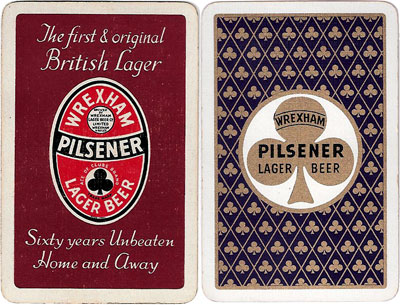
There have been advertising playing cards produced by English manufacturers for Welsh businesses, such as for well over 50 Welsh breweries►
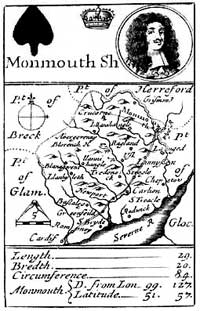
Above: Robert Morden’s Playing Cards, 1676 more►
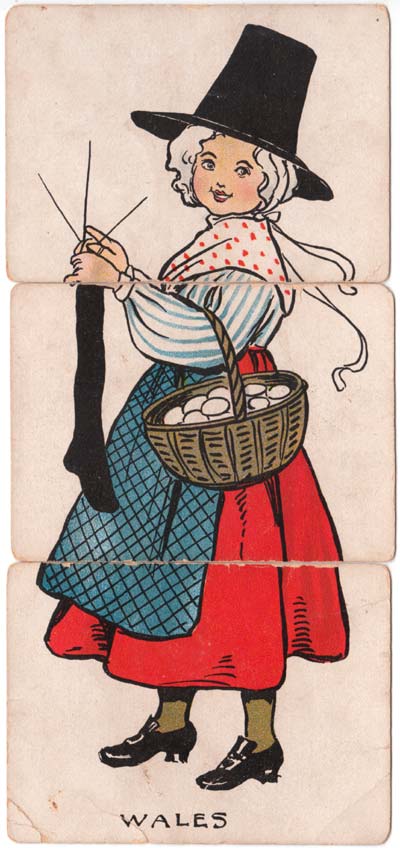
Above: Welsh girl from card game published in England, c.1906 more►
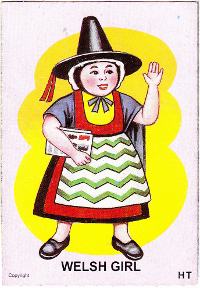
Above: card depicting “Welsh Girl” from a children's card game produced in Malaysia, 1984 see more►
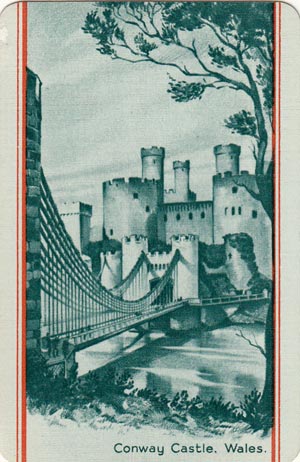
Above: card depicting Conwy Castle from Beautiful Britain series, Waddington's, 1950s.
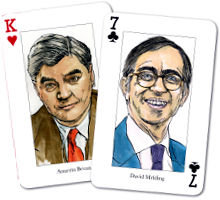
Above: 54 Welsh Politicians on a deck of playing cards more►

Certain early sets of map cards, such as Robert Morden's “The Counties of England and Wales” (1676), possibly the first pocket atlas, depict maps of Wales. The “Geography of England and Wales” was produced in 1799, believed to be by John Wallis, 16 Ludgate Street, London. These cards contain information regarding Boundaries, Extent, Principle Towns and Rivers.
There is of course a succession of packs commemorating the various stages in the careers of the Prince or Princess of Wales, e.g. investiture, marriage, etc. produced by English manufacturers, commencing in the Victorian era. These usually feature coats-of-arms or photographs on the reverse, with standard English courts on the faces. The Prince of Wales is also often depicted in Monarchy card games which have proven very popular on account of their educational value as well as providing a means of amusement.
The eighteenth century playing card manufacturer John Llewellyn, registered in Piccadilly, London, may have been a Welshman, or a descendent of a Welsh family, who had moved away. Owen Jones, the Welsh architect and interior designer who worked for De La Rue in the nineteenth century, created 173 different playing card designs.
During WWII the “Bevin Boy” coal workers enjoyed playing cards in their time off. However, a group that seemed to sit around all day playing cards was taken to court. When asked by the judge “How do you manage to exist?”, the defendant replied “By my wits sir”. The judge said “Then you'd better do six months by your wits” - a great source of amusement around the hostel when heard.
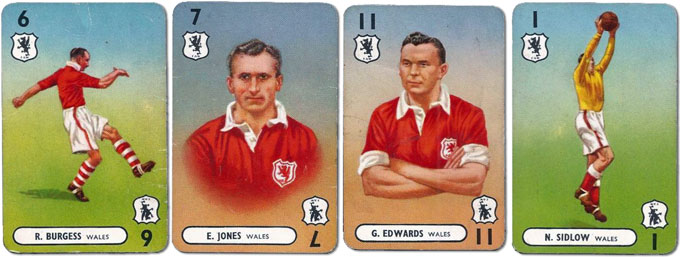
Above: cards showing Welsh football players from International Football Whist game published by Pepys Games, 1947 more →
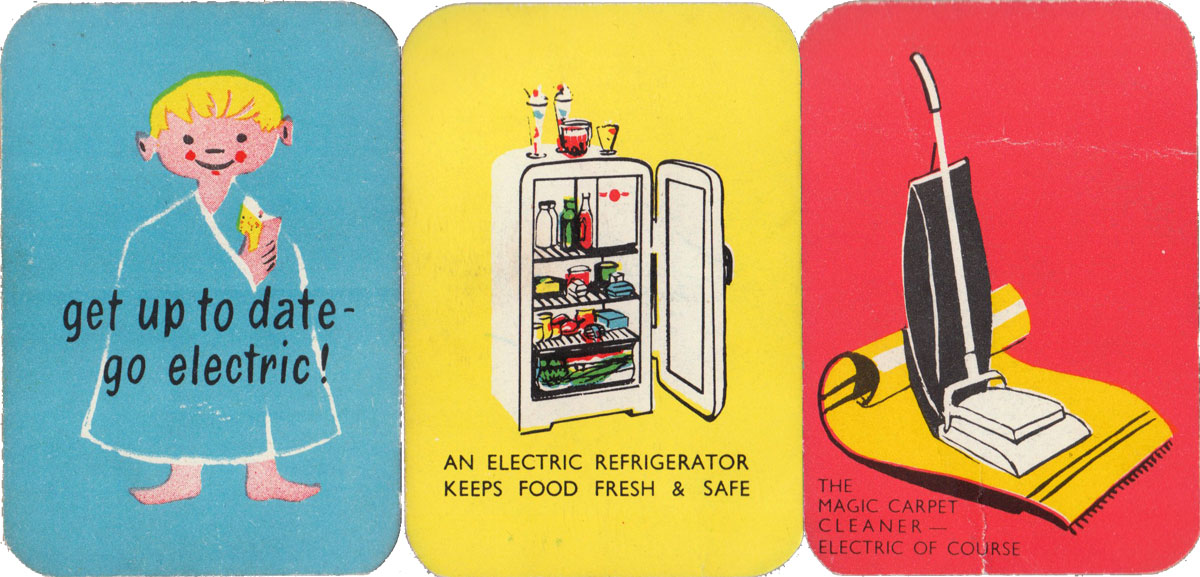
Above: Electric Snap printed and published by the South Wales Electricity Board, 1950s more →
In 1974 the leek was added to the design of Waddington's Ace of Spades. More recently a number of Souvenir of Wales playing cards packs have been published, by John Hinde and others, usually manufactured in the Far East. These either have a Welsh-themed design on the back with standard courts, or photographic scenes of popular tourist locations on each card. There has also been a ‘Welsh Tarot’ pack based upon Welsh mythology and paganism. From time to time Welsh costumes or traditions appear depicted in a stereotyped manner in card games from around the world.
The distinctiveness of Wales is an important part of the texture and variety which characterises the island of Britain, but only a few Welsh playing cards have been found which were actually manufactured in Wales. The Welsh Political Figures playing cards were published in Cardiff but actually manufactured in London!
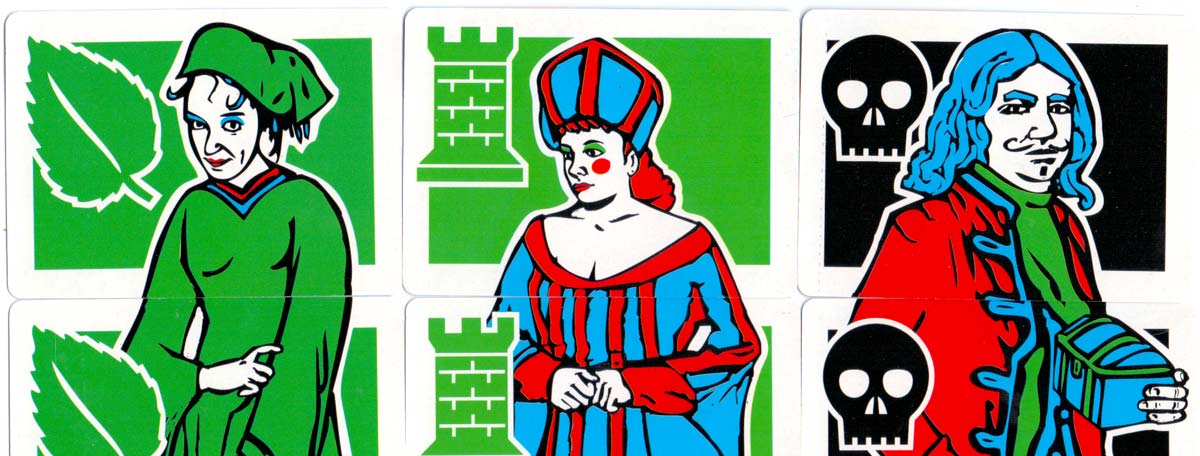
Above: Dwyn - a card game about Welsh history and culture, 2006 see more →
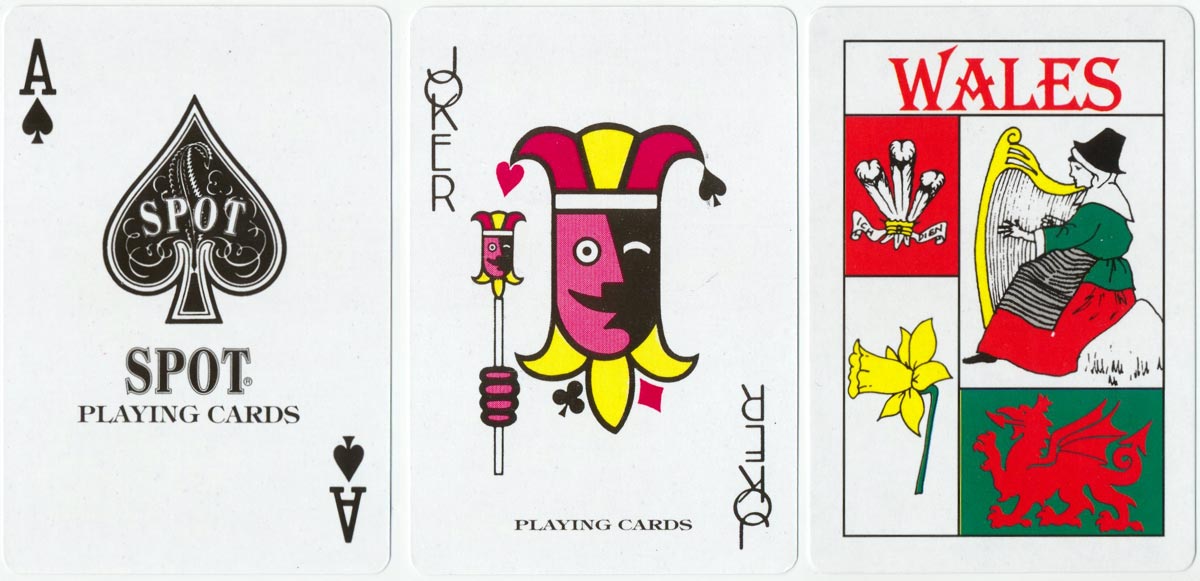
Above: ‘Spot’ brand playing cards made in Indonesia featuring a Welsh-themed back design. Image courtesy Matt Probert.
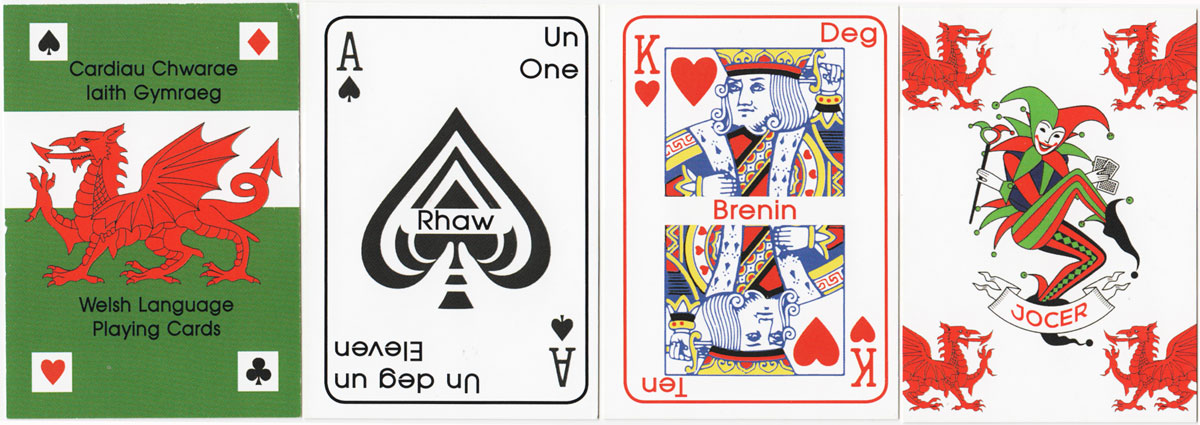
Above: Welsh Language playing cards designed by Richard Ruston-Burgess, 2020 see more →
Satan playing cards on Rhyd-y-Cae bridge, Pentrevoelas
Moralists in Christian communities have always disapproved of gambling. The devil is supposedly attracted, in the hope of gain, to wherever sin is committed, especially on Sundays. The following Welsh version of a traditional fireside story is propaganda against playing cards, influenced by such thoughts.
Robert Llwyd Hari was a servant in Gilar farm, and the champion card player of his day. When going home from Rhydlydan, after a game of cards in Aunty Ann’s house, called the Green, he was met at the end of the cross-lane by a gentleman, who entered into conversation with him. The gentleman asked him to have a game of cards, “I have no cards,” answered Bob, “Yes you have, you have two packs in your pocket,” answered the gentleman. They settled to play on the bridge of Rhyd-y-Cae, as it was a beautiful moonlight night. The gentleman was very pressing that they should go to Plas Iolyn, because they would find there, he said, plenty of light, although no one was then living at the place. But Bob positively refused to go there. They commenced the game in downright good earnest on the bridge, Robert Llwyd winning every game. But a card fell over the bridge into the water, and Bob looked over, and saw that the gentleman had hoofs like a horse. He swore by the Great Being that he would not play any longer, and on this his partner turned himself into a wheel of fire, and departed bowling towards Plas Iolyn, and Bob went home to Gilar.
REFERENCES
Éilís Ní Anluain, The Cardplayers and the Devil (ML 3015): Regional and Social Variation in Ireland, Béaloideas, Iml. 59, The Fairy Hill Is on Fire! Proceedings of the Symposium on the Supernatural in Irish and Scottish Migratory Legends (1991), pp. 45-54
The Calum Maclean Project: calumimaclean.blogspot.co.uk►
Martin, Puhvel, ‘The Legend of the Devil-Haunted Card Players in Northern Europe’, Folk-Lore, vol. 76 (1965), pp. 33–38
Reimund Kvideland Henning K, Sehmsdorf (editors): Scandinavian Folk Belief and Legend, University of Minnesota Press, 1988, Fourth printing 1999

By Simon Wintle
Member since February 01, 1996
I am the founder of The World of Playing Cards (est. 1996), a website dedicated to the history, artistry and cultural significance of playing cards and tarot. Over the years I have researched various areas of the subject, acquired and traded collections and contributed as a committee member of the IPCS and graphics editor of The Playing-Card journal. Having lived in Chile, England, Wales, and now Spain, these experiences have shaped my work and passion for playing cards. Amongst my achievements is producing a limited-edition replica of a 17th-century English pack using woodblocks and stencils—a labour of love. Today, the World of Playing Cards is a global collaborative project, with my son Adam serving as the technical driving force behind its development. His innovative efforts have helped shape the site into the thriving hub it is today. You are warmly invited to become a contributor and share your enthusiasm.
Related Articles

Ogdens Beauties & Military cigarette cards
Cigarette cards featuring beauties and military uniforms with playing-card insets.

Boddingtons Bitter playing cards
Cool-looking courts advertising Boddingtons Bitter, originally brewed in Manchester.

OXO Faces of the Millennium Dinner
Twentieth-century personalities promoting a millennium dinner at the Oxo Tower in London.

Kids Fun Box playing cards
Colourful cards for children with four non-standard suits connected with the natural world.

Tangle Foot Ale
Badger Brewery Tangle Foot strong ale advertising pack.

Scientific Whist
“Scientific Whist” : standard cards with instructions for play on the faces by Chas Goodall & Son, 1...

Agent Provocateur
Branded lingerie collection in a pack of pin-up playing cards.

Nimbus playing cards
Mike Steer’s weather-themed pack with suits in four colours and backs for cardistry.

Agatha Christie and Playing Cards revisited
Agatha Christie uses card-play as a primary focus of a story, and as a way of creating plots and mot...

The Decadent Deck
Studies in the eroticism of the female body by Inge Clayton.

Historic Shakespeare
“Historic Shakespeare” playing cards featuring Shakespearean characters by Chas Goodall & Son.

Copechat Paramount Sorting System
Preserving the past: a specimen deck showcasing edge-notched cards and their ingenious sorting syste...

Heartsette by Herbert Fitch & Co, 1893
A glimpse into a busy print and design office in late Victorian London.

Batman® playing cards
Batman playing cards published by InterCol of London 1989.

Can You Believe Your Eyes?
“Can You Believe Your Eyes?” playing cards featuring visual illusions & other oddities.

Pastime Playing Cards for the Blind
The “Pastime” Playing Cards for the Blind manufactured by Goodall & Son Limd., c.1910.
Most Popular
Our top articles from the past 28 days

